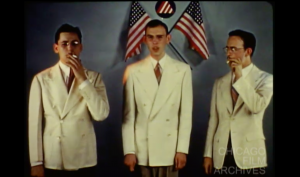
"Three men encourage people to follow rules set by the air raid warden in the event of an air raid. The rules are put to song, and some rules are depicted by actors." Chicago Film Archives
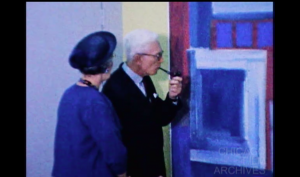
"An amateur film made by and starring the husband and wife duo, John & Evelyn Kibar. The couple visit an art gallery, where John proclaims he can make art just the same. Title cards with dialogue are dispersed throughout the film." Chicago Film Archives
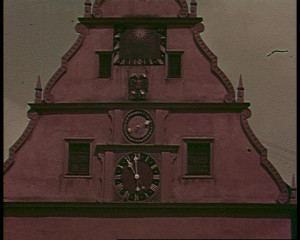
"Brief shot of the Town Hall clock in Rothenburg" (EAFA Database).
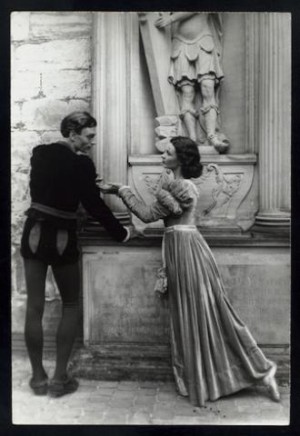
"Silent amateur film shot by John V. Hansen, engineer and member of the Amateur Cinema League, of a performance of Tyrone Guthrie’s Hamlet at Kronberg Castle, Elsinore, Denmark with Laurence Olivier as Hamlet. The first title card states that ‘the oldest metropolitan daily Berlingske Tidende of Copenhagen presents the Old Vic at Kronberg’. The second title states ‘snappy colour-shots from different angles of Scenes from Shakespeare’s ‘Hamlet’'. Film shows audience, cast getting ready and shots taken throughout the play" The Human Studies Film Archive via the British Universities and Film Council.
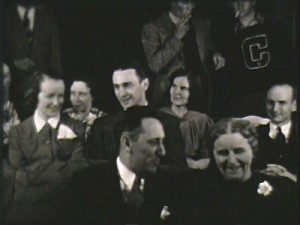
"Brief 1938 film of family and friends descending stairs into the cellar, followed by pan across the seated audience." oldfilm.org
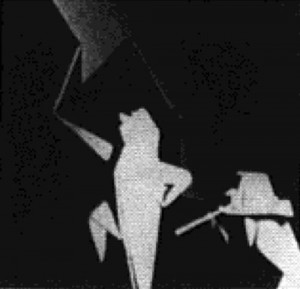
"Many forms of art originated in old Japan. Here is a demonstration of a unique and improbably one that began as entertainment for children. Origami, the art of paper folding, is charmingly portrayed and described in this very imaginative film. One of the Ten Best, it will be enjoyed in the 1963 Top of the Ten pack" PSA Journal, Oct. 1963, 40.
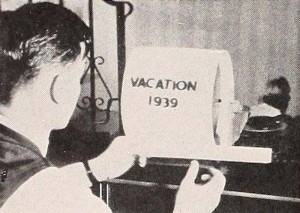
"When movie makers turn to movie making itself as the subject of a picture, sometimes they are a little self conscious and heavy handed — more particularly if the approach is humorous. This fault, the Dallas (Texas) Cine Club has successfully avoided in Out to Win, an opus that displays the adventures of a new convert to filming. The hero of the tale observes that everybody has a movie camera and that he is out of things. So his trombone and the equipment of other hobbies go to the "hock shop" to finance the purchase of a new cine camera. His wife isn't particularly sympathetic to movie making, and here the real humor enters, for Mrs. Movie Maker is not antagonistic; she is just oblivious to the real importance of movies. She walks in on her husband when he is developing titles, she tramps through film clips when he is editing; but, when the movie maker receives an incredible sum for a newsreel scoop (well handled airplane wreck sequence) and, in consequence, gets a check that enables the pair to buy a new car, Mrs. Movie Maker's attitude changes. In the last scene, she is proudly using a camera. The actors are excellent: they do not overplay their roles, and so the film is really funny." Movie Makers, Dec. 1939, 634-635.
"Pipe Dreams, by Joseph Dephoure, ACL, and Edward Atkins, ACL, is ranked among the year's ten best because of its considerable triumphs over dramatic and technical difficulties. Through the imagination of its producers, a small cast, simple settings and moderate footage have been used to tell a big story, rich in pictorial effect. Dreaming that he has murdered his unfaithful wife, a young man sees in prospect the swift and fearful course of his life to the waiting gallows. The murder, the trial, the death cell and the hanging are represented in large part only by the imaginative and striking use of shadows of the real scenes. Occasional straight shots are heightened in effect by unusual angles and dramatic lighting. Sensitively planned, smartly executed and deftly cut, Pipe Dreams makes its simple story exciting and forceful." Movie Makers, Dec. 1933, 500.
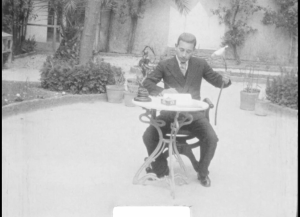
Paradoy of the avantgarde film culture of the era, including references to Salvador Dalí, Luis Buñuel, Joan Miró and dancer Àurea de Sarrà. It is interesting because it shows the crossed dialogue between these different film cultures that functioned beyond the realm of commercial cinema.
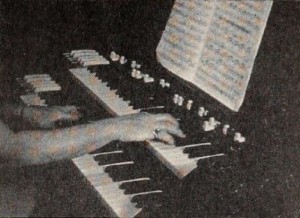
"At the outset of amateur movies' newest medium, magnetic sound on film, Robert G. Williams has accomplished a tour de force with his uncannily perfect synchrony of music to pictures in Poet and Peasant. As Kathryn Williams plays the familiar overture on the Hammond organ, the sound accompaniment matches the hand movements on screen without faltering and without once resorting to tricks or short cuts. Countless closeups of the organist's hands as they play give evidence of Mr. Williams's confidence and ability in the new field. But Mr. Williams also has made a lively and interesting picture from a subject usually so dull and static that, more often than not, it has stumped most professionals. Pacing his film with precision, he has used an amazing variety of camera angles, even shooting from above and behind the organ. Mrs. Williams's playing is competent and assured; but it is Mr. Williams's unusually good filming and recording techniques which bring her abilities vividly to life on screen." Movie Makers, Dec. 1952, 339.
Total Pages: 15